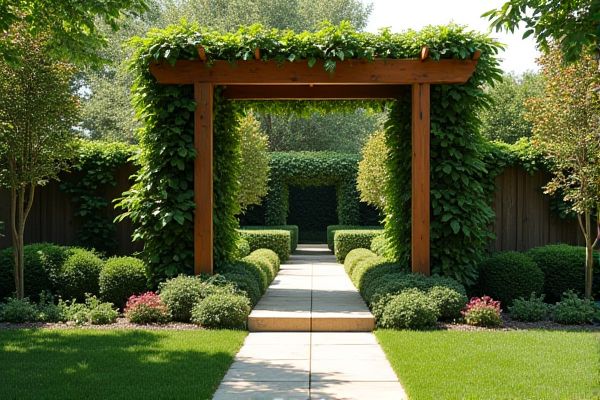
A garden arch provides a tall, elegant entryway often used to support climbing plants or create a focal point, while an arbor typically features a bench or seating area beneath its structure, offering both shade and a cozy retreat in your garden. Explore the full article to discover which option best suits your outdoor space and enhances Your garden's beauty.
Table of Comparison
| Feature | Garden Arch | Arbor |
|---|---|---|
| Structure | Freestanding curved frame, simple arch shape | More complex, includes side panels and sometimes a bench |
| Material | Metal, wood, vinyl | Wood, metal, vinyl, often sturdier materials |
| Function | Decorative entrance or pathway accent | Decorative entrance plus seating and shade |
| Size | Typically smaller and lighter | Larger, heavier, more substantial |
| Plant Support | Supports climbing plants moderately | Designed to support heavier climbing plants or vines |
| Installation | Easier to install and move | Usually more permanent installation |
Introduction to Garden Arch and Arbor
Garden arches and arbors are popular landscape features designed to enhance outdoor spaces with structural beauty and function. A garden arch typically refers to a curved framework that supports climbing plants, creating a vertical focal point for pathways or entrances. Arbors usually offer a broader structure with seating or a shaded nook, providing both aesthetic appeal and a cozy retreat in your garden.
Defining Garden Arches
Garden arches are freestanding structures designed to support climbing plants, creating elegant vertical elements in outdoor spaces. Typically taller and more curved than arbors, garden arches provide a dramatic entrance or focal point in your garden. They often serve as gateways or decorative accents, enhancing the overall landscape design by framing views or pathways.
Defining Garden Arbors
Garden arbors are decorative structures typically made from wood or metal, featuring a curved or flat top and open sides designed to support climbing plants and provide a shaded passageway or seating area in a garden. They differ from garden arches, which are usually simpler, freestanding, single-arched frames primarily used as entryways or focal points without the extended support and enclosed nature of arbors. Garden arbors often include built-in benches and lattice sides, creating a cozy, sheltered spot ideal for relaxation and enhanced garden aesthetics.
Key Differences Between Arches and Arbors
Garden arches typically feature a curved top and open sides, creating a decorative entryway that enhances vertical garden design. Arbors often include a flat or slightly curved roof with side panels or lattice, providing both support for climbing plants and a shaded seating area. Your choice between an arch or arbor depends on whether you want a purely ornamental garden feature or a functional structure for relaxation and plant growth.
Design and Aesthetic Appeal
Garden arches often feature a tall, curved design that creates a graceful entrance or focal point, ideal for climbing plants like roses or wisteria, enhancing vertical interest and elegance in your garden. Arbors typically have a more compact structure with a flat or slightly curved roof, providing both decorative appeal and a cozy shaded seating area, blending functionality with charm. Both options offer unique aesthetic qualities, but your choice depends on whether you prioritize height and openness (arch) or intimacy and shelter (arbor).
Material Choices and Durability
Garden arches are typically constructed from materials like wood, metal, or vinyl, offering varied durability depending on the climate and maintenance. Arbors often feature sturdier hardwoods or wrought iron, providing enhanced strength and longevity for supporting climbing plants. Your choice between a garden arch and arbor should consider material resilience and how it suits the intended outdoor environment to ensure lasting performance.
Functional Uses in Garden Landscaping
Garden arches create elegant vertical focal points and serve as gateways or entrances to different garden areas, enhancing visual interest and guiding foot traffic. Arbors provide both vertical structure and practical seating or shaded resting spots, combining aesthetic appeal with functional comfort in garden landscaping. Your choice depends on whether you prioritize decorative pathways or integrated relaxation spaces in your outdoor design.
Installation and Maintenance Considerations
Garden arches typically require more extensive installation due to their taller and curved structure, often needing secure anchoring in the ground to withstand weather conditions. Arbors, generally smaller and simpler, can be easier to set up and may suit DIY projects with less foundational work. Your choice should consider not only the initial installation complexity but also the ongoing maintenance, as garden arches might need more frequent inspections for stability and cleaning compared to the relatively low-maintenance arbor.
Cost Comparison
Garden arches typically cost less than arbors, with prices ranging from $50 to $300 depending on materials like metal or wood. Arbors often feature more intricate designs and built-in seating, resulting in higher costs between $200 and $1,000 or more. Choosing the right structure for your garden depends on your budget and the desired combination of aesthetics and functionality.
Choosing the Right Structure for Your Garden
Selecting the right garden structure depends on space, style, and function; garden arches typically serve as taller, decorative entryways or transitions, while arbors provide a more substantial framework often featuring seating or climbing plants. Consider materials like cedar or wrought iron and the scale of your garden to ensure the structure complements existing landscaping. Prioritize durability and maintenance requirements to match your long-term garden design goals.
 homyna.com
homyna.com